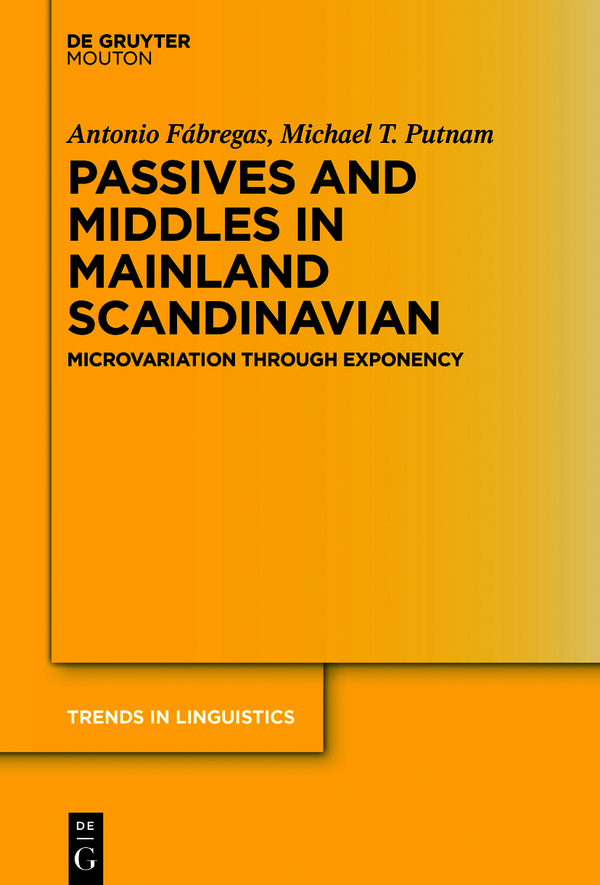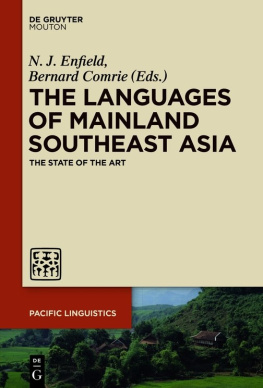Antonio Fábregas - Passives and Middles in Mainland Scandinavian
Here you can read online Antonio Fábregas - Passives and Middles in Mainland Scandinavian full text of the book (entire story) in english for free. Download pdf and epub, get meaning, cover and reviews about this ebook. City: Berlin/Boston, year: 2020, publisher: De Gruyter, genre: Science. Description of the work, (preface) as well as reviews are available. Best literature library LitArk.com created for fans of good reading and offers a wide selection of genres:
Romance novel
Science fiction
Adventure
Detective
Science
History
Home and family
Prose
Art
Politics
Computer
Non-fiction
Religion
Business
Children
Humor
Choose a favorite category and find really read worthwhile books. Enjoy immersion in the world of imagination, feel the emotions of the characters or learn something new for yourself, make an fascinating discovery.

- Book:Passives and Middles in Mainland Scandinavian
- Author:
- Publisher:De Gruyter
- Genre:
- Year:2020
- City:Berlin/Boston
- Rating:4 / 5
- Favourites:Add to favourites
- Your mark:
- 80
- 1
- 2
- 3
- 4
- 5
Passives and Middles in Mainland Scandinavian: summary, description and annotation
We offer to read an annotation, description, summary or preface (depends on what the author of the book "Passives and Middles in Mainland Scandinavian" wrote himself). If you haven't found the necessary information about the book — write in the comments, we will try to find it.
Passives and Middles in Mainland Scandinavian — read online for free the complete book (whole text) full work
Below is the text of the book, divided by pages. System saving the place of the last page read, allows you to conveniently read the book "Passives and Middles in Mainland Scandinavian" online for free, without having to search again every time where you left off. Put a bookmark, and you can go to the page where you finished reading at any time.
Font size:
Interval:
Bookmark:

Trends in Linguistics. Studies and Monographs [TiLSM]
Edited by
Volume
ISBN 9783110633719
e-ISBN (PDF) 9783110670912
e-ISBN (EPUB) 9783110670936
Bibliographic information published by the Deutsche Nationalbibliothek
The Deutsche Nationalbibliothek lists this publication in the Deutsche Nationalbibliografie; detailed bibliographic data are available on the Internet at http://dnb.dnb.de.
2020 Walter de Gruyter GmbH, Berlin/Boston
A common quote touted by formal linguists that has become a bit of a badge of honor validating the importance of their work is that their research seeks to better understand empirical issues and structural phenomena that most others did not know were problems in the first place. An additional confound that can stand in the way of formal analyses is the amount of detail and rigor required to arrive at a better understanding of what was initially perceived to be a simple problem or isolated phenomenon at first. These two descriptions most certainly apply to the book that you are currently reading what began as a conference presentation and eventual write-up for the proceedings (Penn Linguistics Colloquium (PLC) 36, 2013) became an article in The Linguistic Review a year later (The emergence of middle voice structures with and without agents, (2014), 31(2): 193240) and has evolved into a monograph-length treatment of passives and middles in Mainland Scandinavian. We thank Mouton de Gruyter, and Harry van der Hulst, editor of The Linguistic Review, for permission to cite and build upon the initial aspects of this earlier work. Along each step of the way, mostly thanks to editors and reviewers comments as well as helpful and critical comments from colleagues, we realized that we had much more to say about this topic and that we just couldnt call it quits. The empirical data and the microvariation that exists in the fascinating linguistic continuum of Mainland Scandinavian represent a challenge that formal analyses must come to terms with. It is our humble hope that the theoretical analyses put forward here provide a platform from which multiple strands of linguistic research can be carried out in future endeavors.
There are a host of individuals we would like to recognize for their assistance and encouragement throughout this process. We would like to thank the editors of this series, Volker Gast and Chiara Gianollo, for vetting this work with two excellent anonymous reviewers. These reviewers went far beyond the expected call of duty and their comments and suggestions vastly improved and sharpened this manuscript. We are moreover overwhelmed by their generosity in pointing us to data and observations in a constructive way that and we are not overstating anything here the resulting version is better than what we could have achieved just by ourselves. We also wish to thank the following individuals for invigorating discussions about topics connected with this book and/or for assistance with data collection: Tor farli, Artemis Alexiadou, Marcus Axelsson, Angela Hoffman, Eva Klingvall, Bjrn Lundqvist, Janne Bondi Johannessen, Tore Nesset, Florian Schfer, shild Sfteland, Peter Svenonius, Tarald Taraldsen, Ida Toivonen, ystein Vangsnes, and Jim Wood. We would like to recognize Ignacio Bosque, Terje Lohndal, Rafael Marn, and Tom Stroik for being a constant source of excellent ideas and sage advice. Finally, we thank Robert Klosinski for editorial assistance.
Antonio would also like to thank his parents, Carmen and Jos Antonio, for supporting his crazy ideas of studying linguistics when it seemed that there were more typical professional paths, and Carlos Piera for telling him about a place called Troms where that path was exactly the type of linguistics that he was interested in. He would also like to dedicate his work in this book to Carme Picallo, without whose example about how to ask deep questions and to find explanations that went beyond what we assume is correct none of the ideas presented in this book could exist.
Mike would like to thank Jill and Abby for their constant love and support. Over the last decade my research has taken me to Scandinavia quite often, where I have had the opportunity to interact with and befriend many talented linguists. To all of my dear friends and colleagues in places such as Copenhagen, Halden, Oslo, Troms, and Trondheim Takk for vennskap deres! I confess that I am absolutely smitten with your language(s) and culture(s) and greatly look forward to my future visits and collaborations with all of you. I would like to dedicate this book to the loving memory of my paternal grandparents, Robert Edmund Putnam (19272014) and Mary Anne McLaughlin Putnam (19272014), who passed away during the initial stages of writing this book. Thanks for being an excellent example of the importance of faith, family, and helping others.
The purpose of this book is to deliver a detailed analysis of passives and middle voice constructions in Norwegian and Swedish, according to which we derive passives and actives from the same set of syntactic heads, that is, without the use of distinct flavors of Voice-projections. Less attention is paid to anticausative constructions, although we will also address them in this monograph (cf. chapter 6), pointing the way to a more detailed analysis of these constructions in future work.
Agreeing with : Chapter 6 for his suggestion that middle voice constructions in German with a generic interpretation can be treated as voiced anticausatives), to date, to the best of our knowledge, a detailed comparative treatment of ADCs in closely related languages is surprisingly lacking. This work bridges this gap, providing a detailed examination of two closely related Mainland Scandinavian languages, while exposing the impact that these empirical findings will have on any unified treatment of ADCs cross-linguistically irrespective of the theoretical framework employed.
Although they share many other morphosyntactic and semantic similarities, our previous work () has shown that Norwegian and Swedish employ both shared, and at the same time, unique strategies in lexicalizing ADCs that on many occasion differ quite starkly from one another. One of the key challenges in front us is to gain a more enhanced understanding of the differences in these lexicalization strategies, and of equal importance, how these differences in a unified treatment of ADCs affect not only our analysis of Norwegian and Swedish, but how they can also be extended to studies involving other typologically-similar and -diverse languages.
Our focus on ADCs in Norwegian and Swedish has much to bear on the treatment of grammatical voice in recent theoretical work (). The principled goal of syntactic derivations under this view is to produce exponents, which function as an intermediary to make derivational units produced in the syntax legible for interpretation at the Sensori-Motor and Conceptual-Intentional interfaces. We review the properties of these theoretical revisions in Chapter 2.
Both Norwegian and Swedish exhibit passive voice constructions that are morphological (i.e. only involving the bound lexical s-exponent at the end of the verb, cf. 1) and syntactic (i.e. those consisting of an auxiliary verb + a past participle/supine verb, cf. 2) forms:
Font size:
Interval:
Bookmark:
Similar books «Passives and Middles in Mainland Scandinavian»
Look at similar books to Passives and Middles in Mainland Scandinavian. We have selected literature similar in name and meaning in the hope of providing readers with more options to find new, interesting, not yet read works.
Discussion, reviews of the book Passives and Middles in Mainland Scandinavian and just readers' own opinions. Leave your comments, write what you think about the work, its meaning or the main characters. Specify what exactly you liked and what you didn't like, and why you think so.








